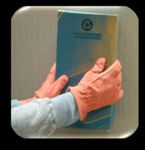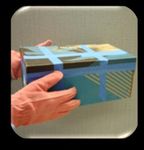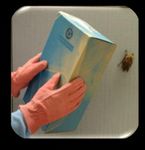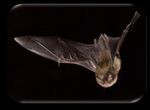I've Found a Bat! What Should I Do? - Wisconsin Humane ...
←
→
Page content transcription
If your browser does not render page correctly, please read the page content below
I’ve Found a Bat! What Should I Do?
Situation: You’ve found a bat either inside your home, school, or workplace, or outside clinging to the side of a
building, on a tree, or lying on the ground.
Why this happens: If a bat is in your home or other
structure, likely points of entry include an uncapped chimney,
open and unscreened (or torn screen) windows, uncovered vents,
a door that has been propped open – even briefly – or holes,
cracks or gaps in the siding, overhangs, or roof. Bats do NOT
chew their way into a building – the entry points they utilize are
pre-existing.
Bats enter buildings for many reasons. In the late fall, winter,
and spring, the bat may have been attempting to hibernate in the
attic but became dehydrated or sick and unintentionally found
their way into your living quarters while searching for water or
warmth. If it is late summer, the bats born this year are on their This is a Big Brown Bat. Despite the “big” in their name,
own for the first time and a young bat may have been looking for a
they are surprisingly small (and adorable!).
place to rest for the day and ended up inside your home by
mistake. If a bat is found outside hanging on a wall or tree, it
may be injured or sick, or it may just be a migrating bat that has stopped to rest. If a bat is found outside on the
ground, it is probably injured, sick, or exhausted. And a mother bat that becomes grounded may be unable to take
flight because she is carrying her “pups” (babies) -- in our area this is a possibility for mother Eastern Red Bats, Hoary
Bats, and Silver-haired Bats.
FAQs and Humane Solutions
”What do I need to know about bats and rabies?”
Rabies is a virus that many mammals, such as dogs, cats, raccoons, etc. may potentially “carry” (it will eventually
make them sick and ultimately it will kill them), but few in Wisconsin actually do. Although only a very small
percentage of bats have the rabies virus, it is still something to take seriously. The rabies virus is passed through the
saliva of a rabid animal, most commonly through a bite or scratch. You cannot get rabies from urine, feces, or blood.
You cannot get rabies from looking at or just being in the presence of a bat or any other animal. For more
information about the rabies virus, visit the Centers for Disease Control and Prevention (CDC) website.
“If rabies isn’t that common, then in what situations involving a bat should I be concerned about a
possible rabies exposure?”
A “possible rabies exposure” means that there was a known bite or scratch from a bat, or that circumstances existed
where a person may have been bitten or scratched without their knowledge, such as a bat was found in a room where
a person was sleeping, or a bat was found in a room with an infant or child or with someone who is incapacitated or
inebriated, or found in a situation where a pet may have been bitten or scratched by a bat. If there is a chance that a
person or pet may have been exposed to the rabies virus, then the bat should be safely contained (see “How to Safely
Contain a Bat”, below) – please DO NOT harm the bat in any way. Then contact your local public health
department to report the possible rabies exposure and get their advice. If you are in Milwaukee County, you may
call us for advice in containing the bat and we’ll let you know if we think you should bring the bat to us.
If you are outside of Milwaukee County, you should contain the bat if you are able to safely do so and contact a local,
licensed wildlife rehabilitator and your public health department."Help! I found a bat in my house! What should I do?”
Do not panic and do not grab a tennis racquet or broom! Keep calm and know that this bat is scared and
attempting to find a way out of the building she accidentally found her way into.
1. Find the bat. Bats will usually try to land on something they can grasp with their tiny feet such as
curtains, or trim molding near the ceiling. If the bat is flying,
do not try to catch the bat in midair as this can injure the bat
and may increase the potential for you to have direct contact
with the bat. It is best to watch and wait until she lands. If you
are unable to locate the bat - determine if there was a known
or possible human or pet exposure (see previous paragraph).
If there was an exposure (bite, scratch, or direct contact with
the bat), or suspected exposure, you should contact your
doctor or local public health department right away for advice.
2. Safely contain the bat (see “How to Safely Contain a Bat”
below).
3. Contact your local licensed wildlife rehabilitator. If you
This little cutie is an Eastern Red Bat. Despite the
are in the area that the Wisconsin Department of Natural
negative stereotypes, bats are very beneficial due
Resources has designated as the Southeast Region, which is
to the vast number of insects they eat.
Milwaukee, Ozaukee, Washington, Waukesha, Walworth,
Kenosha, and Racine Counties*, then call the Wisconsin Humane
Society Wildlife Rehabilitation Center at 414-431-6204. If you are outside of Milwaukee County, you can
find your closest licensed wildlife rehabilitator here. (*Note: in response to the confirmation of White-nose
Syndrome in Wisconsin, the WI DNR has implemented very specific regulations for the rehabilitation of
cave-roosting bat species in the state. We CANNOT legally admit bats from outside our region. If you are
outside of our region, we will refer you to the closest rehabilitator in your region).
“If I bring you a bat that I found inside my house, what will you do
with it?”
IMPORTANT! Please DO NOT bring a bat to the Wisconsin Humane
Society Wildlife Rehabilitation Center unless you’ve talked to us first!
There is concern among bat conservationists that the novel
coronavirus that causes COVID-19 in humans could accidentally be
passed by humans to Wisconsin’s bats, with devastating results for bat
populations. Thus, the Wisconsin Department of Natural Resources,
who regulates all wildlife rehabilitators, has temporarily banned bat
rehabilitation in Wisconsin. As a result, sadly, we are only permitted to
admit bats for humane euthanasia, such as when a bat must be
presented for rabies testing or is severely injured.
Here we’re hand-feeding mealworms to a Big
Brown Bat in care at our wildlife hospital.
“I found a bat OUTSIDE. What should I do?”
1. If you think the bat may be injured AND/OR is on the ground, contact your local wildlife rehabilitator. If
you are in Milwaukee County, call the Wisconsin Humane Society Wildlife Rehabilitation Center at
414-431-6204. If you are outside of Milwaukee County you can find your closest wildlife rehabilitator here
or call us for a referral.
2. If the bat appears to be uninjured and is hanging on a building, tree, or other vertical surface, we
recommend you contact your local licensed wildlife rehabilitator before you contain the bat. If it is
relatively warm outdoors and it is during migration in spring or fall, this bat may be resting during the day
and migrating at night. The rehabilitator may recommend that you leave the bat alone and check back
early the following morning to see if the bat has left during the night. IMPORTANT! Please DO NOT
bring a bat to the WHS Wildlife Rehabilitation Center unless you’ve talked to us first!“I discovered that there are bats in my attic (or eaves). What should I do?”
If you have bats in your attic or eaves, please visit Bat Conservation International, Bat
World Sanctuary, or The Wisconsin Bat Program’s exclusion page for detailed information
on how bats may be entering your home, and if you choose to take action, how to
humanely exclude them from your home. If you
don’t own the property, we strongly recommend you contact your landlord as well.
If you decide to hire a company to exclude bats from your home, know that in the
state of Wisconsin it is illegal to exclude bats during the breeding season
(May through August) without first consulting with the Wisconsin
Department of Natural Resources. Responsible bat excluders do exist, so call
around to make sure you are hiring an excluder that follows the law and treats the
bats with kindness and respect. If a company informs you that they will kill the
bats or are willing to exclude bats during months when it is illegal – do NOT hire
this company and instead report them to the DNR by calling 1-800-WNDR-TIP.
Also, if you plan to exclude bats, while this is humane during certain times of the
year, know that you are still essentially kicking them out of their home – they will
have to find a new roost, and this can be difficult for them. We suggest you
consider providing man-made bat houses as an alternative housing option. This Hoary Bat mom was found injured on the
Information on how to build (or buy) a proper bat house and how they should be ground with her two nursing pups. She is
placed can be found on the Bat Conservation International and Bat World holding both of them in this picture. We are
Sanctuary websites. We sell our own Bat Conservation International- pleased to report that this family was
certified bat houses online! rehabilitated and successfully released!
“There are bats living on the outside of my house behind my window shutters. What should I do?”
The easiest and most humane thing to do is to leave them alone. As long as your house is secure, there is no chance for
them to enter your home – bats do not create entry points; they merely utilize pre-existing ones. Your shutters are
essentially functioning as bat houses, giving these marvelous little flying-insect eaters a secure place to hide and rest. If
you absolutely need the bats to leave, follow the suggestions for humane exclusion provided at the web sites shown in
the paragraph directly above.
“How can I help bats?”
Bats do need our help: more than half of the species in Wisconsin are listed as
“state threatened” species. Their numbers are at risk for many reasons including
habitat loss, overuse of pesticides, and most recently, a disease called White-nose
Syndrome, caused by an invasive fungus which has killed MILLIONS of bats in the
last few years (learn more about White-nose Syndrome here.
• Keep your pets, even indoor-only pets, up-to-date on their rabies
vaccinations to help protect your pet and the bat if you should find a
bat inside your home or if your pet finds a bat on the ground outside.
• Ensure your living quarters are bat-proof. Preventing bats from
entering your living space will prevent a possible rabies exposure for
your family and help protect the life of any bat that wanders into the
living space of your home from the possible need for rabies testing.
• Install a bat house – See free bat house plans and mounting and
location recommendations (proper bat house design and placement
really does matter!) on Bat World or Bat Conservation International. Bats must be nimble and aerobatic fliers to catch
We sell our own Bat Conservation International-certified bat their dinner of insects in flight.
houses online! Photo credit: Erik Huebler
• Share your appreciation and knowledge about bats with others! These beneficial creatures are plagued by
human persecution caused by myth and mystery. This lack of understanding on our part leads to fear which
often, in turn, leads people to cause these wonderful animals harm. Tell other people how awesome they are!
• PLEASE DONATE to the Wisconsin Humane Society’s Wildlife Rehabilitation Center, one of just a
handful of authorized bat rehabilitation centers in the state.How to Safely Contain a Bat
Please do NOT harm or kill the bat! Besides the fact that bats are living creatures capable of feeling fear and pain,
should the bat need to be tested for rabies, the bat’s brain must be intact and undamaged in
order for the test to be done. So ultimately, to protect the people and pets involved, it is
important that the bat is not injured or killed.
Do not handle the bat directly!! But you should still wear lightweight leather gloves
during this process as an additional level of protection from physical contact.
Get a shoebox or some other container of similar size and a flat piece of cardboard or
similar material that will completely cover the opening of the box. Using a pencil or pen,
poke a few air holes in the sides of the box, but make sure there are no holes in the box
larger than a dime and no gaps between the lid and the box.
Find the bat. If she is flying around, wait until she lands. Bats will usually try to land on
something they can grasp with their tiny feet such as curtains, or trim molding near the
ceiling. Do not try to catch the bat in midair as this can injure the bat and may increase
your chance of touching the bat. It is best to watch and wait until she lands.
Without touching the bat, place the box over the bat to enclose her between the box and
the surface she is clinging to. She may make some screeching or hissing noises – this is
okay – she’s just scared!
Next, gently slide the flat piece of cardboard between the box and the surface she is on to
trap the bat in the box. We flattened the lid of the shoebox and used that. Once contained,
tape the lid or flat piece of cardboard securely to the box.
*Note: in response to the confirmation of White-nose Syndrome in Wisconsin, the WI DNR also requires
you place the box into another box or bag for transport.
**If you are in the area that the Wisconsin Department of Natural Resources has designated
as the Southeast Region, which is Milwaukee, Ozaukee, Washington, Waukesha, Walworth,
Kenosha, and Racine Counties, please call the Wisconsin Humane Society Wildlife
Rehabilitation Center in Milwaukee and leave a message.
IMPORTANT! Please DO NOT bring a bat to the WHS Wildlife Rehabilitation Center
unless you’ve talked to us first! There is concern among bat conservationists that the
novel coronavirus that causes COVID-19 in humans could accidentally be passed by humans
to Wisconsin’s bats, with devastating results for bat populations. Thus, the Wisconsin
Department of Natural Resources, who regulates all wildlife rehabilitators, has temporarily
banned bat rehabilitation in Wisconsin. As a result, sadly, we are only permitted to admit
bats for humane euthanasia, such as when a bat must be presented for rabies testing or is
severely injured.
If you are outside of the Southeast Region or are unable or unwilling to contain the
bat, we urge you to contact your local public health department immediately or call
us at 414-431-6204 for a referral
©Wisconsin Humane Society, 2021
The Wisconsin Humane Society is a charitable organization that depends entirely on donations to fulfill its mission to
create a community that values animals and treats them with respect and kindness. Your support for the WHS Wildlife
Rehabilitation Center makes possible the distribution of information like this to thousands of people who request it each
year and makes possible the humane care of over 5,000 injured, sick, and orphaned wild animals from our community
each year. You may donate online or by mailing a check to the following address: WHS Wildlife Center, 4500 W.
Wisconsin Avenue, Milwaukee, WI 53208You can also read



























































